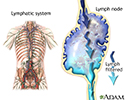Lymph system
Lymphatic systemThe lymph system is a network of organs, lymph nodes, lymph ducts, and lymph vessels that make and move lymph from tissues to the bloodstream. The lymph system is a major part of the body's immune system.
Information
Lymph is a clear-to-white fluid made of:
- White blood cells, especially lymphocytes, the cells that attack bacteria in the blood and body tissues
- Fluid from the intestines called chyle, which contains proteins and fats
Lymph nodes are most often soft, small, round- or bean-shaped structures. They usually cannot be seen or easily felt. They are located in clusters in various parts of the body, such as the:
- Neck
- Armpit
- Groin
- Inside the center of the chest and abdomen
Lymph nodes mainly store immune cells that help the body fight infection but are also places where these cells can be made. They also filter the lymph fluid and remove foreign material such as bacteria and cancer cells. When bacteria are recognized in the lymph fluid, the lymph nodes make more infection-fighting white blood cells. This causes the nodes to swell. The swollen nodes are sometimes felt in the neck, under the arms, and groin.
Cancer
Cancer is the uncontrolled growth of abnormal cells in the body. Cancerous cells are also called malignant cells.
Read Article Now Book Mark ArticleSwollen nodes
Lymph nodes are present throughout your body. They are an important part of your immune system. Lymph nodes help your body recognize and fight germ...

The lymph system includes the:
- Tonsils
- Adenoids
- Spleen
- Thymus
References
Ball JW, Dains JE, Flynn JA, Solomon BS, Stewart RW. Lymphatic system. In: Ball JW, Dains JE, Flynn JA, Solomon BS, Stewart RW, eds. Seidel's Guide to Physical Examination. 10th ed. Philadelphia, PA: Elsevier; 2023:chap 10.
Hall JE, Hall ME. The microcirculation and lymphatic system: capillary fluid exchange, interstitial fluid, and lymph flow. In: Hall JE, Hall ME, eds. Guyton and Hall Textbook of Medical Physiology. 14th ed. Philadelphia, PA: Elsevier; 2021:chap 16.
-
Lymphatic system - illustration
The lymphatic system filters fluid from around cells. It is an important part of the immune system. When people refer to swollen glands in the neck, they are usually referring to swollen lymph nodes. Common areas where lymph nodes can be easily felt, especially if they are enlarged, are the groin, armpits (axilla), above the clavicle (supraclavicular), in the neck (cervical), and the back of the head just above hairline (occipital).
Lymphatic system
illustration
-
Lymphatic system - illustration
Lymph nodes produce immune cells to help fight infection. They also filter the lymph fluid and remove foreign material, such as bacteria and cancer cells. They can become swollen from inflammatory conditions, an abscess, cancer, and most commonly from infection. Common areas where lymph nodes can be felt include the groin, armpit, behind the ears, back of the head, sides of the neck and under the jaw and chin.
Lymphatic system
illustration
-
Lymphatic system - illustration
The lymphatic system filters fluid from around cells. It is an important part of the immune system. When people refer to swollen glands in the neck, they are usually referring to swollen lymph nodes. Common areas where lymph nodes can be easily felt, especially if they are enlarged, are the groin, armpits (axilla), above the clavicle (supraclavicular), in the neck (cervical), and the back of the head just above hairline (occipital).
Lymphatic system
illustration
-
Lymphatic system - illustration
Lymph nodes produce immune cells to help fight infection. They also filter the lymph fluid and remove foreign material, such as bacteria and cancer cells. They can become swollen from inflammatory conditions, an abscess, cancer, and most commonly from infection. Common areas where lymph nodes can be felt include the groin, armpit, behind the ears, back of the head, sides of the neck and under the jaw and chin.
Lymphatic system
illustration
Review Date: 7/23/2024
Reviewed By: Linda J. Vorvick, MD, Clinical Professor, Department of Family Medicine, UW Medicine, School of Medicine, University of Washington, Seattle, WA. Also reviewed by David C. Dugdale, MD, Medical Director, Brenda Conaway, Editorial Director, and the A.D.A.M. Editorial team.




